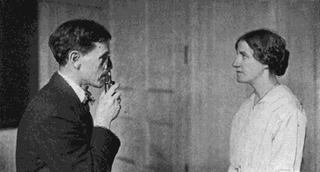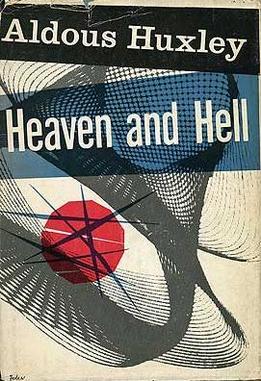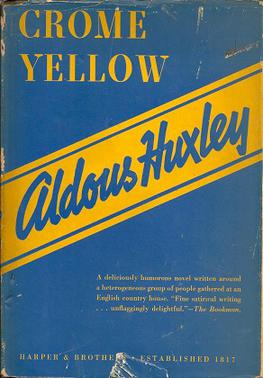
Aldous Leonard Huxley was an English writer and philosopher. His bibliography spans nearly 50 books, including novels and non-fiction works, as well as essays, narratives, and poems.

The Doors of Perception is an autobiographical book written by Aldous Huxley. Published in 1954, it elaborates on his psychedelic experience under the influence of mescaline in May 1953. Huxley recalls the insights he experienced, ranging from the "purely aesthetic" to "sacramental vision", and reflects on their philosophical and psychological implications. In 1956, he published Heaven and Hell, another essay which elaborates these reflections further. The two works have since often been published together as one book; the title of both comes from William Blake's 1793 book The Marriage of Heaven and Hell.

Brave New World is a dystopian novel by English author Aldous Huxley, written in 1931 and published in 1932. Largely set in a futuristic World State, whose citizens are environmentally engineered into an intelligence-based social hierarchy, the novel anticipates huge scientific advancements in reproductive technology, sleep-learning, psychological manipulation and classical conditioning that are combined to make a dystopian society which is challenged by the story's protagonist. Huxley followed this book with a reassessment in essay form, Brave New World Revisited (1958), and with his final novel, Island (1962), the utopian counterpart. This novel is often compared to George Orwell's Nineteen Eighty-Four (1949).

Stereoscopy is a technique for creating or enhancing the illusion of depth in an image by means of stereopsis for binocular vision. The word stereoscopy derives from Greek στερεός (stereos) 'firm, solid', and σκοπέω (skopeō) 'to look, to see'. Any stereoscopic image is called a stereogram. Originally, stereogram referred to a pair of stereo images which could be viewed using a stereoscope.

The Bates method is an ineffective and potentially dangerous alternative therapy aimed at improving eyesight. Eye-care physician William Horatio Bates (1860–1931) held the erroneous belief that the extraocular muscles effected changes in focus and that "mental strain" caused abnormal action of these muscles; hence he believed that relieving such "strain" would cure defective vision. In 1952, optometry professor Elwin Marg wrote of Bates, "Most of his claims and almost all of his theories have been considered false by practically all visual scientists."

Scrying, also known by various names such as "seeing" or "peeping", is the practice of looking into a suitable medium in the hope of detecting significant messages or visions. The objective might be personal guidance, prophecy, revelation, or inspiration, but down the ages, scrying in various forms also has been a means of divination or fortune-telling. It remains popular in occult circles, discussed in many media, both modern and centuries old.

Island is a 1962 utopian manifesto and novel by English writer Aldous Huxley, the author's final work before his death in 1963. Although it has a plot, the plot largely serves to further conceptual explorations rather than setting up and resolving conventional narrative tension.
Human echolocation is the ability of humans to detect objects in their environment by sensing echoes from those objects, by actively creating sounds: for example, by tapping their canes, lightly stomping their foot, snapping their fingers, or making clicking noises with their mouths. People trained to orient by echolocation can interpret the sound waves reflected by nearby objects, accurately identifying their location and size.

Heaven and Hell is a philosophical essay by Aldous Huxley published in 1956. Huxley derived the title from William Blake's book The Marriage of Heaven and Hell. The essay discusses the relationship between bright, colorful objects, geometric designs, psychoactives, art, and profound experience. Heaven and Hell metaphorically refer to what Huxley conceives to be two contrary mystical experiences that potentially await when one opens the "doors of perception"—not only in a mystical experience, but in prosaic life.

Crome Yellow is the first novel by British author Aldous Huxley, published by Chatto & Windus in 1921, followed by a U.S. edition by George H. Doran Company in 1922. Though a social satire of its time, it is still appreciated and has been adapted to different media.
Stereopsis is the component of depth perception retrieved through binocular vision. Stereopsis is not the only contributor to depth perception, but it is a major one. Binocular vision happens because each eye receives a different image because they are in slightly different positions on one's head. These positional differences are referred to as "horizontal disparities" or, more generally, "binocular disparities". Disparities are processed in the visual cortex of the brain to yield depth perception. While binocular disparities are naturally present when viewing a real three-dimensional scene with two eyes, they can also be simulated by artificially presenting two different images separately to each eye using a method called stereoscopy. The perception of depth in such cases is also referred to as "stereoscopic depth".
Matthew Luckiesh DSc, DE, was a physicist and, as the Director of General Electric's Lighting Research Laboratory at its Nela Park National Lamps Works facility in East Cleveland, Ohio, he pursued research on light and vision. In his day, he was known as the "Father of the Science of Seeing."

Fixation disparity is a tendency of the eyes to drift in the direction of the heterophoria. While the heterophoria refers to a fusion-free vergence state, the fixation disparity refers to a small misalignment of the visual axes when both eyes are open in an observer with normal fusion and binocular vision. The misalignment may be vertical, horizontal or both. The misalignment is much smaller than that of strabismus. While strabismus prevents binocular vision, fixation disparity keeps binocular vision, however it may reduce a patient's level of stereopsis. A patient may or may not have fixation disparity and a patient may have a different fixation disparity at distance than near. Observers with a fixation disparity are more likely to report eye strain in demanding visual tasks; therefore, tests of fixation disparity belong to the diagnostic tools used by eye care professionals: remediation includes vision therapy, prism eye glasses, or visual ergonomics at the workplace.
The See Clearly Method was an eye-exercise program that was marketed as an alternative to the use of glasses, contact lenses, and eye surgery to improve vision. Sales were halted by legal action in 2006. The method is not supported by basic science, and no research studies were conducted prior to marketing. The program is based in part on the Bates method, an alternative therapy devised in the early 20th century, which lacks clinical evidence to support the claim that it can improve eyesight.

Margaret Darst Corbett was an American who promoted the discredited Bates method in an attempt to improve eyesight. She became famous after her prosecution and acquittal on a charge of practicing medicine without a license. Ophthalmologists dismissed Corbett's ideas as quackery.
Flash suppression is a phenomenon of visual perception in which an image presented to one eye is suppressed by a flash of another image presented to the other eye.
Mind at Large is a concept proposed by Aldous Huxley to help interpret psychedelic experience. He maintained that the human mind filters reality under normal circumstances and that psychedelic drugs remove the filter, exposing the user to a Mind at Large.

The neural correlates of consciousness (NCC) refer to the relationships between mental states and neural states and constitute the minimal set of neuronal events and mechanisms sufficient for a specific conscious percept. Neuroscientists use empirical approaches to discover neural correlates of subjective phenomena; that is, neural changes which necessarily and regularly correlate with a specific experience. The set should be minimal because, under the materialist assumption that the brain is sufficient to give rise to any given conscious experience, the question is which of its components are necessary to produce it.
Arts-based environmental education (AEE) brings art education and environmental education together in one undertaking. The approach has two essential characteristics. The first is that it refers to a specific kind of environmental education that starts off from an artistic approach. Different from other types of outdoor or environmental education which offer room for aesthetic experiences, AEE turns the tables in a fundamental way. Art is not an added quality, the icing on the cake; it is rather the point of departure in the effort to find ways in which people can connect to their environment. A second fundamental characteristic is that AEE is one of the first contemporary approaches of bringing together artistic practice and environmental education in which practitioners also made an attempt to formulate an epistemology.

The following bibliography of Aldous Huxley provides a chronological list of the published works of English writer Aldous Huxley (1894–1963). It includes his fiction and non-fiction, both published during his lifetime and posthumously.












